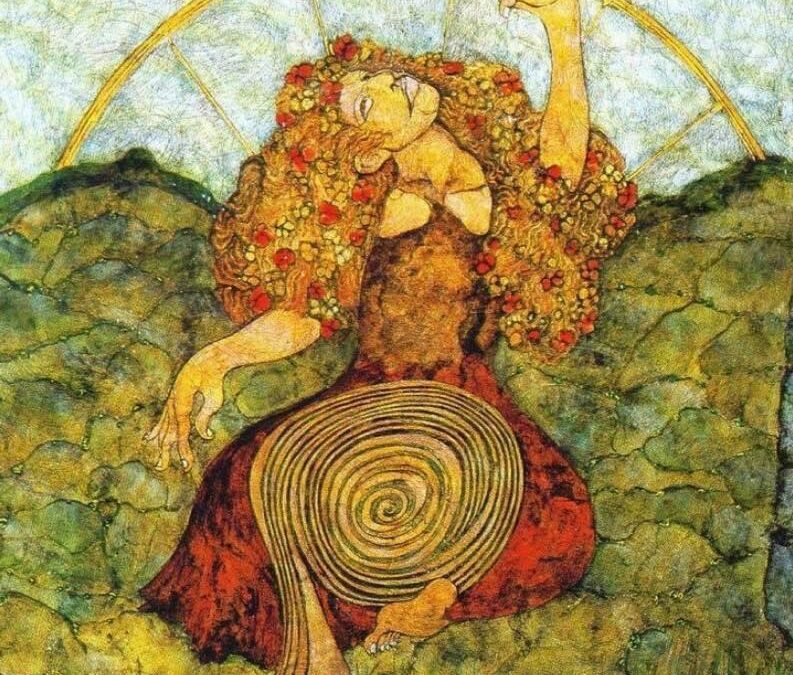A Somatic Approach to Healing Trauma, Pain, and Disconnection | Columbus, OH
By Sharon Hartnett, LMT, CST-D, Hakomi and SPI support
I never did expect that I would become a craniosacral therapist. Like many people, I started with a desire to help others feel better—but I hadn’t yet discovered the kind of work that would change me, and also support others from the inside out.
In the early days, I briefly began with massage therapy. It taught me the importance of touch, but something felt missing. It didn’t move me in a way that felt meaningful. So I moved into structural integration, a bold and powerful way to realign the body. I learned to look and feel the fascia and understand the interconnection within. The results were visible—but the work was very assertive, and over time, it wore on my own body. I needed something more sustainable, more nourishing. Bodyworkers need to listen to their own bodies with care, so they can do the same for others.
What I found was Craniosacral Therapy. Or maybe, it found me.
The Gentle Work That Goes Deep
When I first encountered CST in 2003, I was skeptical, as I practiced mostly Barbara Brennan’s work and deep fascial work in an embodied somatic way. I didn’t understand all the brain and spinal anatomy along with the Craniosacral System. I really hadn’t heard about it much until I received it myself from a local Craniosacral Therapist in McLean, Virginia names Suzanne. She was something else, and I felt very nourished and my internal environment began to shift in a new way. So I wondered-could something this gentle really create meaningful change?
As I trained, practiced, and received sessions myself, I saw just how powerful CST was—especially when paired with somatic awareness. It supported not just the body, but the whole person. I watched people soften, unwind, and remember who they were beneath my hands as we worked with the pain, the anxiety, the disconnection.
This work changed me too. It taught me the power of the feminine in healing—how to listen rather than fix, to support rather than push, to witness rather than direct. I’ve come to trust that real healing happens when we make space for what’s already inside someone to emerge. Rather, it’s the balancing between the empty listening and the emerging movement that creates powerful change. It’s the blend.
What People Feel After a Session
After a session, people often say: “I didn’t know I could feel this relaxed.”
That deep nervous system settling is more than just a nice feeling. It’s a gateway. In that stillness, the body begins to unwind old trauma. Emotions surface and release. Thoughts become clearer. Pain softens.
But it’s not always instant. Believe it or not- some people feel so unfamiliar with peace and deep relaxation that it takes a few days—or a few sessions—for the benefits to truly land. That’s understandable with the stressful lives we live in. Also, healing isn’t linear, and it’s never one-size-fits-all. It’s a relationship—between your body, your story, and the presence of someone who knows how to listen. Everyone shifts and changes at their own unique pace. Usually, it takes about 5 sessions to truly feel the work making a big impact.
Healing Is Personal: Stories from the Table
One woman came to me after surviving abuse. For the first 10 sessions, I didn’t touch her. Instead, I sat a few feet away—listening, witnessing, letting her body begin to feel safe again. Slowly, over time, her system began to tremble, release, and open. We weren’t just releasing trauma; we were helping her relationship to her own body to heal. It was beautiful and full of grace. Eventually we were able to do minimal hands on Craniosacral Therapy.
Another client came in after a serious concussion symptoms which she had been dealing with for two years. Her thinking was foggy, her balance off, and she was highly sensitive to light. After ten sessions, her clarity returned. A few months later, she enrolled in yoga teacher training—and today, she’s a craniosacral therapist herself. An amazing therapist honestly.
There was also a woman in hospice care, diagnosed with terminal cancer. I saw her weekly for six months, using only the lightest touch. The doctors had given her 6 months to live—but months later, she was still alive, and eventually the doctors told her children that the cancer had gone. I don’t claim to know what happened. But I do know that something in her body responded to being met with gentleness and of course her own “inner wisdom”. Something in her chose to live due to all the help around her.
These stories aren’t about miracles thought They’re about what happens when someone finally feels safe, seen, and supported—on every level. There are so many possibilities in outcomes.
Why Somatic Presence Matters
Craniosacral Therapy works deeply with the nervous system, fascia, and energetic body. When combined with somatic therapy—like the Hakomi method, Upledger dialogue, and trauma-informed techniques—it becomes even more powerful.
In my sessions, I guide people to sense what’s happening inside: not just the symptoms, but the felt sense beneath them. I ask gentle questions. I reflect what I see. I stay in curiosity, allowing each person’s own inner wisdom to lead the way.
This is not about fixing. It’s about remembering and reconnecting. It’s a powerful self-discovery process.
But… Does It Really Work?
People sometimes ask, “Can such a light touch actually do anything?”
It’s a fair question—especially in a culture that prizes doing, pushing, and proving. But the body doesn’t need to be forced to heal. It needs to be listened to. It’s inner wisdom needs to be ignited to do the powerful work it is capable of doing.
There’s science to back CST, yes—but more importantly, there’s your own experience. I always say: try 4 to 6 sessions. See how you feel. The proof is in your body, not in statistics.
An Invitation to Come Home to Yourself
Whether you’re carrying trauma, living with chronic pain, struggling to sleep, or just feeling off—there is hope. And you don’t have to go through it alone.
In my Columbus, Ohio Craniosacral practice, I offer craniosacral therapy informed by decades of somatic training and real-life experience. I’ve worked with women, men, teens, and children. Sensitive people. Stressed-out people. People trying to heal from what they’ve never been able to name.
If you’re ready to feel more like yourself again—more relaxed, more present, more whole—I invite you to come in. Not for a fix. But for a beginning.
Because healing isn’t about becoming someone new.
It’s about remembering who you are.
Warmly, Sharon Hartnett CST-D
Upledger Trained and Certified and serving the Columbus, Ohio area.
614 653-8111
To learn about my Craniosacral Therapy services, visit my main page here











